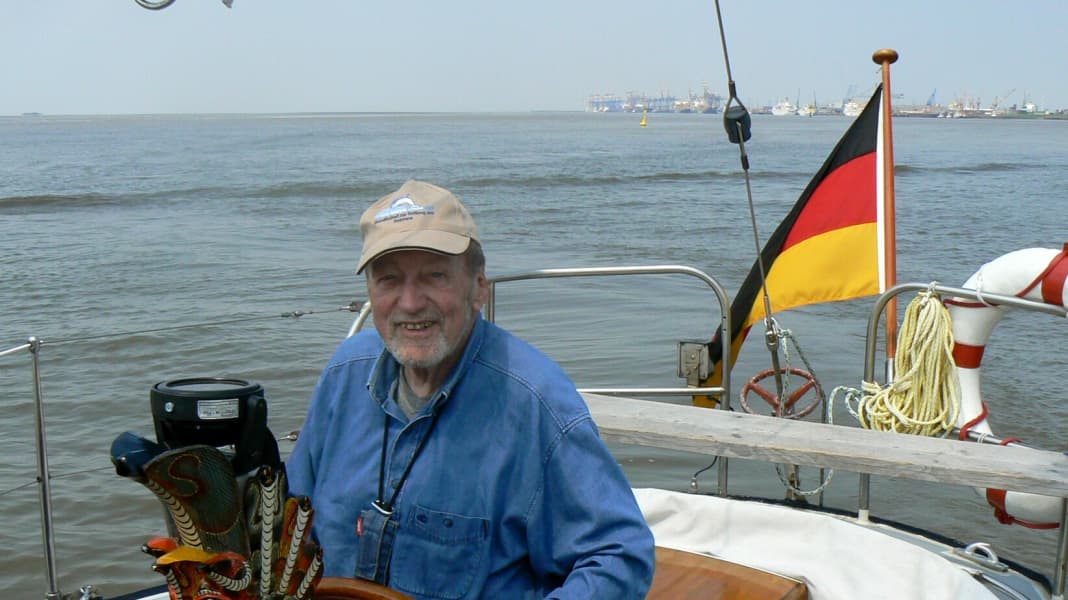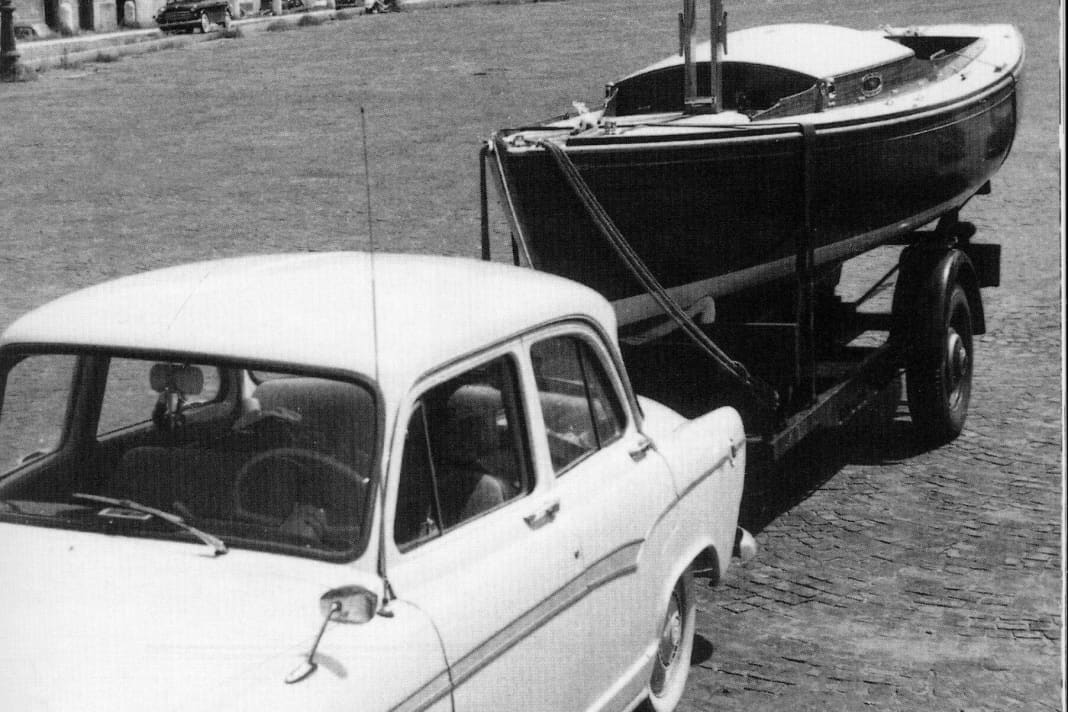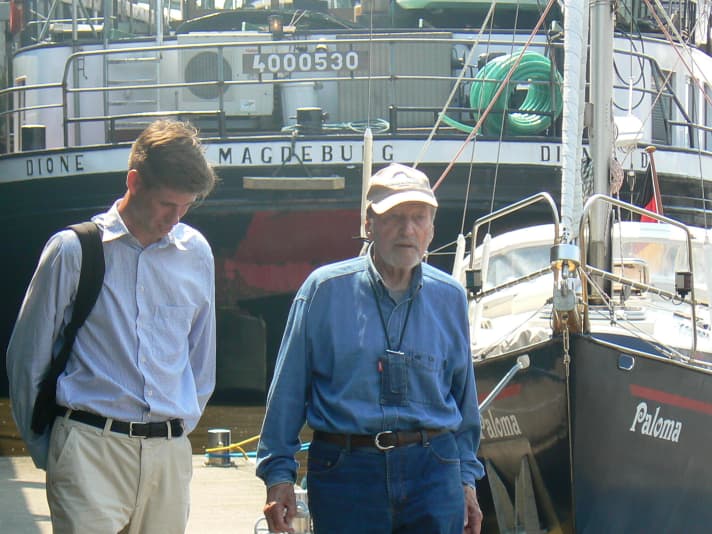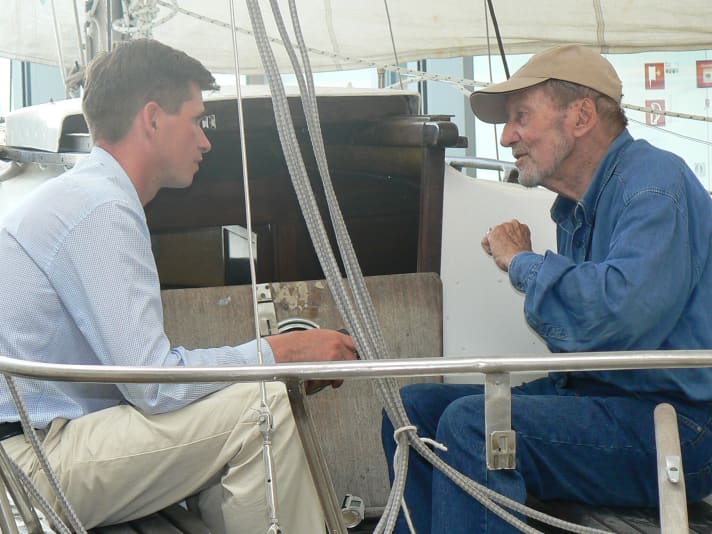
In 2007, our editor Lasse Johannsen spoke with Rollo Gebhard - it was his last in-depth interview with YACHT.






"What do you think you're doing in the last hour?"
40 years after his first circumnavigation, Rollo Gebhard returns to the "Solveig III". The ideal place to review his career.
It is something of a homecoming. Rollo Gebhard walks purposefully towards the ship that once made him famous. He has no eye for the other exhibits in the exhibition. Forty years ago, he began the first of three round-the-world voyages with the "Solveig III". And when he left it to the Bremerhaven Maritime Museum two decades later, he promised: "I'll be back, because the boat is a part of me." Today is the day.

The 86-year-old nimbly climbs the ladder and clambers aboard. He opens the sliding hatch and puts the bulkhead aside. With alert blue eyes, he inspects the tiny saloon and nods with satisfaction. Then he scrutinises the deck, as he has done thousands of times. There seems to be an invisible bond between the boat and its former skipper. Satisfied, Gebhard makes himself comfortable in the cockpit. It seems as if he has never been away.
YACHT: Mr Gebhard, how do you feel as a visitor on the famous old "Solveig III" after such a long time?
Rollo Gebhard:Joy and pain. I have wonderful memories of the boat, but it is painful that there is no question of travelling on it again. The seven years I spent on this boat were some of the most important in my life. And that is now over forever.
Why did you sail around the world twice with it? Was the first one not enough for you?
I didn't sail the same route, but chose a completely different one the second time in order to experience something new. I have always planned my trips with the idea in mind that we humans need to gather knowledge in order to educate our souls.
Gathering insights - is that the main inspiration of a solo sailor?
Yes, but I would have to talk about that at greater length. I lived in the lap of the forces of nature and after a few months I developed an intimate relationship with nature. That's why I never had to listen to a weather report during the two circumnavigations with this boat. I felt the weather, I knew what was coming. I was also never unpleasantly surprised as long as I was sailing alone. I didn't mind the loneliness at sea very much.
But you are not a solo sailor by nature.
That's right. I had my first sailing experiences in the 1950s on Lake Starnberg together with my girlfriend at the time, Jutta. In 1958, we came up with the idea of loading my H dinghy onto a trailer and driving across the Alps to Italy in my little 1000 cubic centimetre car. We launched the boat into the water near Venice with the help of three Italians. Then we sailed to Trieste and later to Tunisia. Jutta's parents weren't allowed to know about it. She had written holiday cards in advance and a friend sent them to Jutta's parents one by one - so of course they had no idea that their daughter was sailing the Mediterranean with me.
How did your love of single-handed sailing develop?
I had the desire to go on a really big trip one day. Once in a lifetime, as I thought at the time, I wanted to sail for a whole year. Of course, my 17-year-old girlfriend couldn't be away from school for that long. That was the only reason I became a solo sailor.
Their undercarriage was hardly suitable for such an undertaking.
I had bought a Hansa dinghy from Abeking & Rasmussen for this purpose. She was a bit bigger, had a hint of a cabin, but no cooker. I sailed through the Mediterranean and the entire Red Sea with her and after two capsizes I was faced with a fundamental decision: Do I want to continue this type of sailing - at the risk of my life and completely without resources? I knew that a capsize could happen again at any time. But I also saw what I was getting in return. There was virtually no tourism at the time. I had been in Egypt for three months with my boat and had seen an incredible amount. I had stood alone for hours at Tutankhamun's tomb and soaked up the atmosphere. When I thought about all these experiences, I decided: "Yes, it was worth it! I'll keep going!"
Your first achievements were a minor matter?
Records were not my goal. Nevertheless, I was the first person to sail alone through the entire Red Sea in such a small, capsizable boat. For ten days and ten nights, I sailed the Hansa dinghy against the monsoon. It doesn't stop at night either. I was simply exhausted. The dinghy didn't have a self-draining cockpit. I had to scoop out every litre of water that the sea had thrown in by hand.
Was piracy already an issue back then?
In Yemen, I was promptly attacked on the first night. That night, a two-masted dhow under sail approached, wonderfully romantically illuminated by the full moon. A crazy sight! Six armed men approached me. I had already been warned that it is a custom of the locals there to kill uninvited guests. As I was still working as an actor at the time, it wasn't difficult for me to mime the invited guest. I acted delighted, patting everyone on the back, stroking their submachine guns, which I knew to be their sanctuaries. When the men let me know they were taking me with them, I calmly shaved and put on my best clothes. I did it so solemnly that nobody dared to push me. So I was freshly shaved and well dressed, and I also had my "first big press" with me, a long article from a Cairo newspaper about my trip. I showed it around. I still don't know if anyone was able to read what it said.
How did you escape?
The six of them drove me through the night to their settlement. They had an old castle in the middle of the desert, with a drawbridge and a moat. When they dragged me inside, I was sure: "Now they're going to kill you!" After hours in a barren cell, my kidnappers came back with their boss, told the whole story and waited for him to decide what to do with me. They finally let me go. I don't know why. I then went to my boat and sailed it back to Aden. There I loaded it onto the next passenger liner to Europe, to Piraeus. From there I travelled on my own keel to Italy, where I had the trailer pick me up.
Fear of death would have been an understandable reason not to embark on such adventures in future.
The Red Sea was the negative experience, I had done everything wrong. But I immediately bought a new boat from the Isle of Wight, made of plywood. I sailed across the Atlantic with it and was a huge success. I did everything right on that trip. I was celebrated like a hero in New York.
And that's when you came up with the idea of sailing around the world?
Yes, when I came back from New York, I started preparing my plywood boat for sailing around the world.
But that didn't happen. Instead, you went on a cruise with your Condor, which we are currently sitting on. Why did you change your plans?
That's a nice story. My former girlfriend Jutta had married a journalist in the meantime. One day she called me and said: "My husband gave me a boat as a present and I want you to christen it!" I didn't like doing this at all, because I thought it was impossible for my husband to invite his long-time friend. After the christening, I left as quickly as possible. But the very next morning, Jutta rang again and asked: "Would you like to have a boat like that?" I had never given it a second thought, I couldn't afford something like that. But she replied: "I'll make sure you get it as a present!" And indeed, one day I got a call from Stöberl ...
... by Helmut Stöberl, the designer of the Condor ...
... yes, and he asked: "Do you really want this boat?" I said: "If you can give it to me for free, I'd love to!" He wanted it, as I was pretty well known back then after the Atlantic crossing. However, the delivery was very delayed and I got it half-finished for two months in preparation for my circumnavigation. "Unfortunately, I can't deliver it to you at Lake Starnberg," said Stöberl, "because there are so many people there who have already paid and are waiting for their Condor to be delivered, they'll just hang the boat off my towing vehicle when I drive up with it. I'll put your boat on the Ammersee, nobody knows it there. But please: don't tell anyone!" Shortly before the circumnavigation, the boat returned to the shipyard and was made ready. The tiller and pushpit were fitted on the last night before my departure.
Which circumnavigation left the strongest impressions?
The first time is always stronger in terms of impression.

How is it then that you wrote so much more extensively about the second circumnavigation?
Because I hadn't put anything down on paper until the end of my second circumnavigation! It was only afterwards that my current wife encouraged me to write, and my publisher naturally wanted something about the current voyage. It was only in my later book "Seefieber" that I published a chapter about the first circumnavigation.
In your first book, "A Man and His Boat", one adventure story follows the next. Are you exaggerating or was everything really always such a big spectacle?
That was it! Now imagine someone arriving in New York in one of these boats in 1967 ...
You were exotic.
They thought I was crazy! In the Caribbean, I met maybe two or three other German sailors. They looked at my little boat and declared me insane.
How risky was the venture? Did the boat behave reasonably well?
Dreamlike, dreamlike! I sailed the boat twice around the world and it steered itself day and night - without a windvane or anything like that! I achieved distances of 150 nautical miles several times, something I didn't even manage later on my Hallberg-Rassy 42! At some point I learnt that they had made a special effort with my boat. Stöberl had instructed his boat builders: "If there are any pieces of lead left here, throw them into the keel!" I reckon I had twice as much ballast in the keel as the other Condors. And the keel bolts - look, they're still the same - even withstood a collision with a whale.
That explains why you chose the relatively uncomfortable "Solveig III" again for the second circumnavigation and didn't buy a larger ship.
No, the reason was completely different! I had a record shop and a house in Garmisch at the time. When I came back from my first trip around the world, I realised that the two sales assistants I had left behind for three years had had a good time. The shop was not only broke, it had run up debts of 90000 marks. I was totally impoverished. I had no choice but to sell my house. I paid off the debts, put some of the rest of the money into the boat for the new trip and kept some left over for the journey.
Why did you refurbish your boat and not your business?
The record shop really wasn't a life fulfilment for me. Especially not after travelling the world. I always asked myself: What do you think in your last hour? The answer shouldn't be: "I sold records!"
About the person
Rolf "Rollo" Gebhard's sailing career began in the mid-fifties with Klepper boat trips on Lake Starnberg and H-dinghy trips in the Mediterranean. He then sailed the Red Sea and the Indian Ocean in a five-metre Hansa dinghy, his first "Solveig". In 1963/64, he made his first Atlantic crossing in the "Solveig II", a 5.60-metre Caprice plywood boat. Never before had a smaller boat completed the ocean passage.
With the "Solveig III", a 7.30 metre Condor, Gebhard completed two single-handed circumnavigations (1967-1970 and 1975-1979). The third circumnavigation, together with his wife Angelika, lasted from 1983 to 1991, during which the couple sailed their Hallberg-Rassy 42 non-stop over more than 16,000 nautical miles from Cairns in Australia to Emden.
After his return, the Trans-Ocean Prize winner founded the Society for the Rescue of Dolphins and from then on undertook extensive expeditions with motorboats, including around Europe.
Through numerous books and lectures, Rollo Gebhard became one of the most famous sailing adventurers of his time. Most recently, his "Logbook of a Life" was published by Delius Klasing Verlag.
Gebhard now lives with his wife in Bad Wiessee on Lake Tegernsee.

